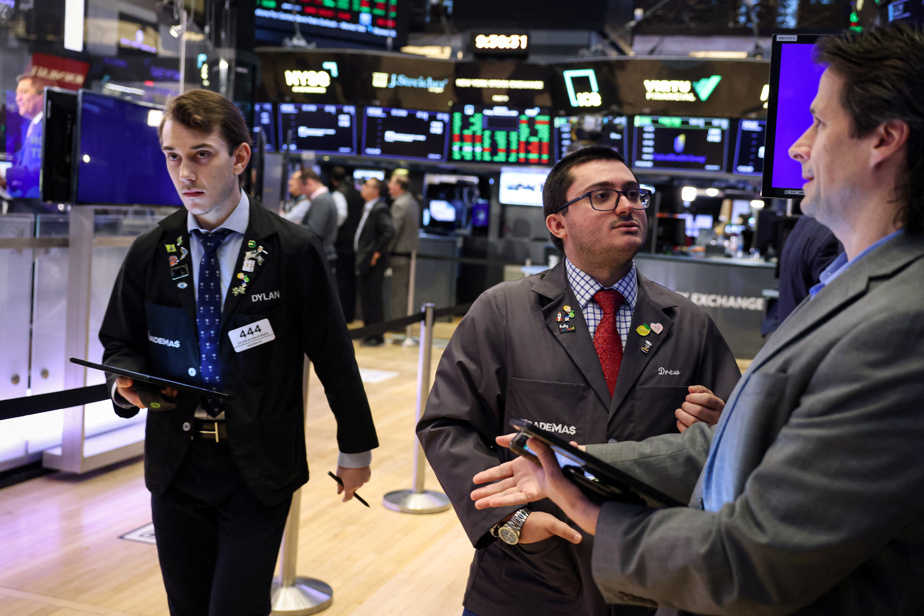(New York) The New York Stock Exchange ended slightly lower on Wednesday, catching its breath after a new surge in the indices, in a waiting position before the publication of a major inflation indicator on Thursday.
The Dow returned 0.06%, the NASDAQ index lost 0.55% and the broader S&P 500 index dropped 0.17%.
“We remain on a very strong climb, and we take a break today,” commented Angelo Kourkafas, from Edward Jones.
This parenthesis was encouraged by the absence of major indicators or publications from Wall Street heavyweights.
“Several giant capitalizations in the technology sector fell back and took the indices with them,” underlined Angelo Kourkafas.
Alphabet was the most affected (-1.91%), ahead of chip makers Intel (-1.73%), Qualcomm (-1.05%) and Nvidia (-1.32%), superstar of the rating since a year.
The inflection was nevertheless moderate and many stocks even recovered at the end of the session.
“The scenario remains unchanged, overall”, estimates Angelo Kourkafas, with “a solid labor market and an economy [américaine] which continues to be resilient.”
The bond market also took a side step. The yield on 10-year US government bonds stood at 4.26%, compared to 4.30% the day before at the close.
“The good news”, according to Angelo Kourkafas, “is that the stock market remained calm as the forecasts of rate cuts evolved” from the American central bank (Fed), Wall Street reducing the rate from 6 to 3. number of blows he expects this year.
“We are in the process of concluding a very good results season and now we are focusing again on inflation and the trajectory of interest rates,” said the analyst.
The New York market is already looking ahead to Thursday’s publication of the PCE price index, the most important inflation measurement parameter for the Fed.
After two bad figures on the CPI and PPI indices, the other major price markers in the United States, Wall Street does not rule out a jump in the PCE. “But it would really take a big surprise” to tense up the market, according to Angelo Kourkafas.
On the market, the cryptocurrency exchange platform Coinbase (+0.79%) only marginally benefited from the surge in bitcoin, which crossed the symbolic threshold of $60,000 per unit on Wednesday, for the first time since November 2021.
The digital currency investment site was, in fact, the victim of a malfunction which saw the balance of several customers display zero, even though the company assured that the assets were there.
The health insurer UnitedHealth (-2.95%), the largest weighting in the Dow Jones (8.6% of the index), pulled the index down after the Wall Street Journal reported on Tuesday that an investigation by the Department of Justice into possible anticompetitive practices within the Minnetonka (Minnesota) company.
The Novavax laboratory fell (-26.74%) after recording a turnover lower than expected in the last quarter of 2023 and losses higher than expected. Investors were also disappointed by the forecasts for the current financial year. The group is suffering from the slowdown in the pace of vaccinations against COVID-19.
Wall Street welcomed the results, beyond its expectations, of the eBay platform (+7.88%), in which analysts saw a sign of the resilience of e-commerce.
Disney progressed (+1.26%) after the announcement of its alliance with the conglomerate Reliance, which will allow it to form a new television giant in India, with a claimed 750 million viewers.
The TSX falling

PHOTO FRANK GUNN, CANADIAN PRESS ARCHIVES
Canada’s main index fell on Wednesday, led by weakness in base metals, while U.S. markets also continued to fall from last week’s highs.
U.S. markets hit record highs last week after another blowout earnings report from chipmaker Nvidia.
“I think we’re just seeing things moving away from the highs a little bit, which is normal,” says Allan Small, senior investment advisor at iA Private Wealth Management.
However, this is a moderate decline on the part of investors, according to Mr. Small.
The S&P/TSX Composite Index closed down 75.13 points at 21,243.77.
The U.S. economy grew 3.2% between October and December, according to a Commerce Department report, down slightly from its initial estimate.
“Overall, there is no mistake, the United States is growing,” says Mr. Small. And their growth exceeds what could have been expected at present. And that delays interest rate cuts. »
But the most important report this week is the one on the basic price of personal consumption, which will appear on Thursday, says Mr. Small. This is the Fed’s preferred inflation indicator.
The current economic strength, while technically bad news for anyone hoping for a rate cut, is a “win-win” for investors, Mr. Small argues.
According to him, this is explained by the fact that the American Federal Reserve has a lot of room to reduce its rates if this proves necessary.
“If the market were to weaken at this point, and things were to get worse very, very quickly […] then the Fed could cut rates,” he says.
The same goes for the Bank of Canada, believes Mr. Small, even if the economic situation is much weaker than south of the border.
“I think the slowdown is happening on both sides of the border, but we are experiencing it much faster than the United States,” he maintains.
In Canada, this week, bank profits continue to flow, according to reports from the Royal Bank and the National Bank on Wednesday.
Although banks’ profits have been mixed so far, they have one thing in common, Mr. Small points out: They are setting aside more money for bad debts, preparing for a more vulnerable consumer.
On the currency market, the Canadian dollar traded at 73.67 US cents, compared to 73.96 US cents on Tuesday.
On the New York commodity exchanges, the price of crude oil fell 33 cents to US$78.54 per barrel and that of natural gas jumped eight cents to US$1.89 per million BTU.
Gold was down US$1.40 at US$2,042.70 an ounce and the copper contract lost a cent to US$3.84 a pound.
